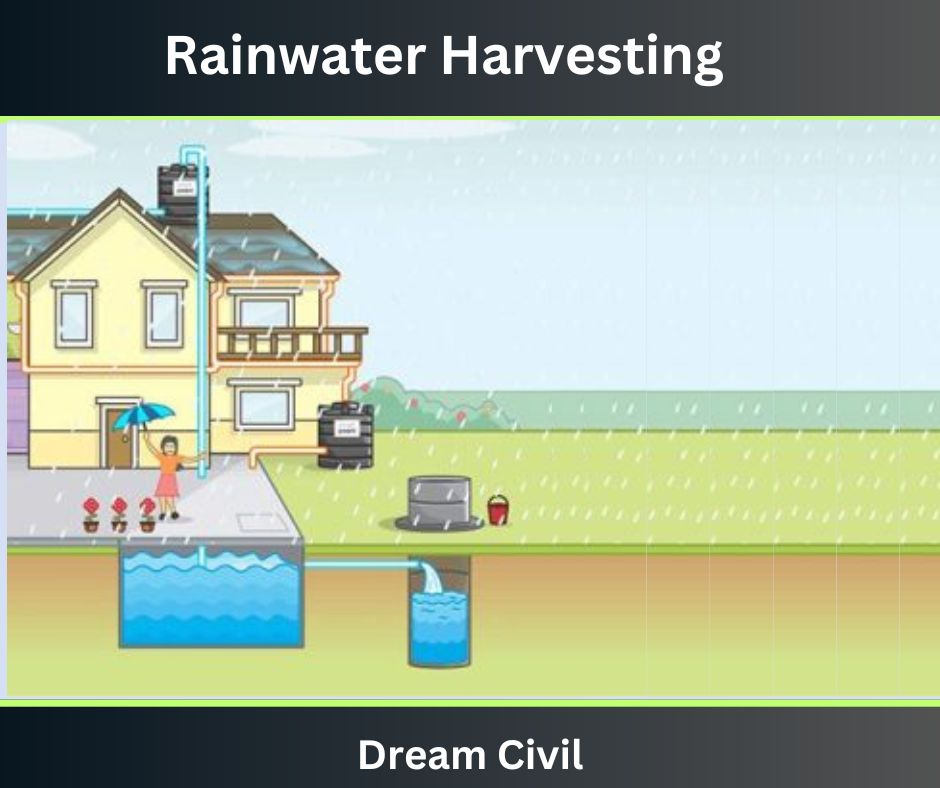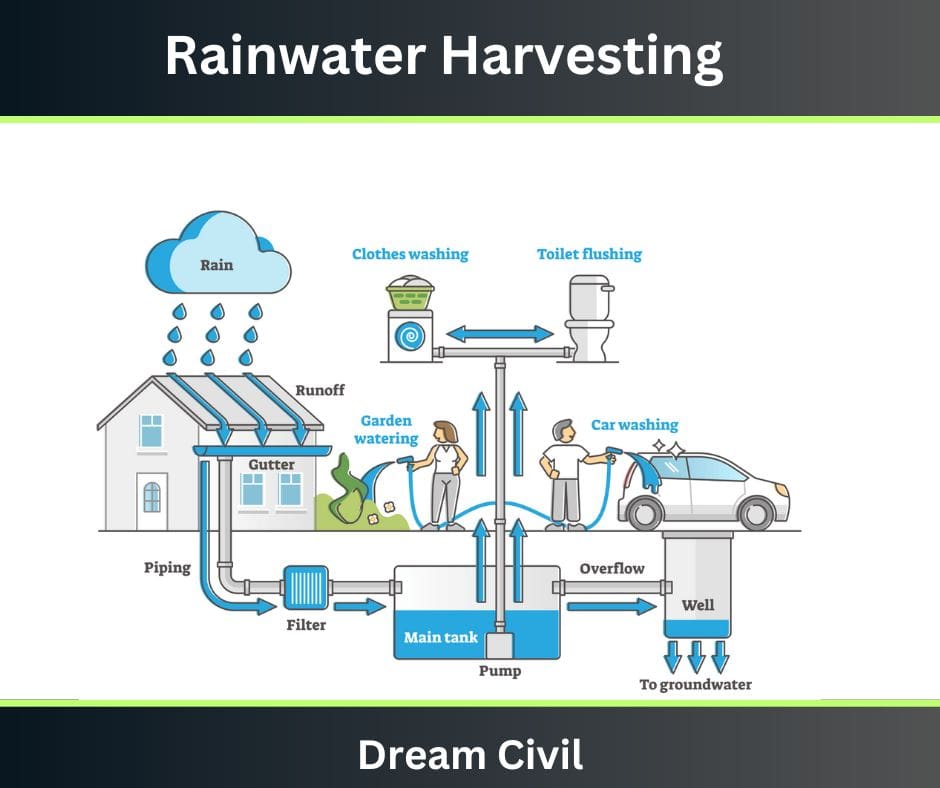Table of Contents
Water is considered the basis of life as it is a vital natural resource for sustaining life on Earth. It is essential for both domestic use as well as for commercial use. Water is used for drinking, washing, electricity generation, irrigation, recreation, navigation, and so on.
Thus, the widespread use of water resources has increased the need for determining new sustainable sources of water resources. One such source of water resources is rainwater harvesting. Two methods of rainwater harvesting are explained below.
Rainwater harvesting is the method of collection and storage of rainwater in tanks, cisterns, and other natural and artificial storage units.

It is a very effective technique for collecting an ample amount of rainwater which can be used for various domestic and other purposes.
Rainwater harvesting can also be defined as the technique of collection, storage, and utilization of the rainwater that falls on roofs and other surfaces for immediate as well as future use by means of storage tanks or recharging of the collected rainwater into subsurface sources such as tube wells.
2. Objectives of Rain Water Harvesting
The main objectives of rainwater harvesting can be listed as follows:
a. To meet the water demand of the growing population and solve the problem of inadequacy in the water supply.
b. To increase the underground water levels.
c. To ensure sustainable use and storage of water.
d. To increase agricultural production and improve the groundwater quality of a particular area by dilution.
e. To improve the ecological balance.
3. Suitability of Rainwater Harvesting
It is desirable to establish a rainwater harvesting system in the areas where;
a. Underground water levels are significantly depleting at frequent intervals.
b. Availability of groundwater is minimal, particularly during the dry season.
c. Subsequent de-saturation of the underground water source has occurred.
d. Other sources of water are not adequate.
4. Methods of Rainwater Harvesting
Basically, two major methods of rainwater harvesting are used namely rooftop rainwater harvesting and surface runoff harvesting.

a. Surface Runoff Water Harvesting
Surface Runoff Water Harvesting is commonly used in urban areas.
Surface Runoff water harvesting can be defined as the method of collection, accumulation, treatment, and storage of runoff water for immediate and future use.
Most commonly the collected water is used for the recharging of subsurface aquifers.
The method can also utilize the runoff from other catchment areas, manmade surfaces, road surfaces, parks, gardens, etc.
If an appropriate method is used, this method can efficiently collect a large amount of water. However, a suitable method of treatment must also be provided as the runoff water may contain certain impurities.
The surface runoff harvesting method can be used for solving the problem of water scarcity as well as the problem of submergence.
Usually, for the storage of the collected water, reservoirs provided with earthen bunds or embankments are excavated in the ground.
The size of such a reservoir may range up to 12 ha.
Benefits of Surface Runoff Harvesting
Some of the benefits offered by surface runoff harvesting can be listed as follows:
a. This method can be used to collect water for agricultural use and irrigation.
b. The water collected can be efficiently used for other products and livelihood purposes.
c. This method of rainwater harvesting is environmentally compatible.
d. It prevents the loss of freshwater to the sea and oceans.
b. Rooftop Rainwater Harvesting
In rooftop rainwater harvesting; rainwater is collected directly from the rooftop of buildings.
In this system, the roof of the building serves as the catchment from which the water is transferred to the storage reservoirs and artificial recharge systems.
Rooftop rainwater harvesting is a commonly adopted method of rainwater harvesting as it is economical and highly useful.
i. Components of Rooftop Rainwater Harvesting
A typical rooftop rainwater harvesting system consists of the following major components:
a. Rooftop (Catchment)
The rooftop serves as the catchment in rainwater harvesting.
The catchment is the component of the rainwater harvesting system that directly receives the rainfall i.e. the surface upon which the rainwater falls directly.
Such a catchment may be a terrace or rooftop of a building.
The catchment basically serves as the water contributor in the system.
b. Pipes (Conveyance)
Another essential component of the rainwater harvesting system is the pipes.
The pipes are also commonly referred to as the conveyance as it serves as the medium to carry the collected rainwater from the catchment to the storage reservoirs and tanks.
In general, the accumulated rainwater from the rooftops and terraces is caught by means of the gutters from which the water is further conveyed by means of the pipe.
Mostly, the UV-resistant pipes such as HDPE pipes, PVC pipes, etc are used for the purpose of rainwater harvesting.
It must be noted that the mouth of the drain must be provided with wire mesh to check the entry of debris and other floating matters.
c. First Flush
Usually, the rainwater that is collected may contain certain impurities initially. Thus, the first accumulated rainwater is flushed off in order to prevent the contamination(like acid rain) of the water stored in the reservoirs.
The device used for this purpose is known as the first flush.
The first flush must be provided in each outlet of the drain pipe.
d. Filters
Filters are the components of the rainwater harvesting system used for the treatment of accumulated rainwater.
Filtration of rainwater is done so as to remove the possible impurities that may be present in the water, remove pathogens, turbidity in water, etc.
The water from the first flush is further passed to the filter where purification of the water takes place.
Various types of filters can be used as per the requirement. Some of the commonly used filters are as follows:
1. Sand Gravel Filter
2. Charcoal Filter
3. PVC Pipe Filter
4. Sponge Filter
e. Storage Unit
The storage unit is used to store the collected water.
A wide range of storage units can be used depending on the scale of the harvesting system.
In the case of the small-scale roof harvesting system, small storage units such as storage tanks, ceramic or plastic jars, drums, etc are commonly used.
On the other hand, for large-scale harvesting systems, large storage tanks usually made up of Ferro cement or cement rings, etc are mostly used.
ii. Types of Rooftop Rainwater Harvesting
The rooftop rainwater harvesting can be further classified into the following types:
a. Rooftop Rainwater Harvesting Method of Storage for Direct Use
In this method, the rainwater accumulated at the catchment is directly diverted or passed to the storage unit.
Usually, a large storage tank is used as the storage unit which is primarily designed based on the water demand, requirements, and expected rainfall.
The system basically consists of the catchment, conveyance pipes, first flush, filters, and storage tank.
In addition, an overflow system is also provided to account for the excess water collected. Alternatively, the excess water may also be used for underground recharge.
This is a very common method of rainwater harvesting as it is highly cost-effective.
The rainwater can be effectively stored during the rainy season and thus ample amount of water will be available for the dry periods.
This method is also energy efficient as it prevents the distribution and transportation of water.
b. Rooftop Rainwater Harvesting Method for Recharging Groundwater Aquifers
In this method, the accumulated water from the catchment is used primarily for the purpose of recharging the subsurface aquifers.
It can be further classified into the following:
1. Recharging of bore wells
2. Recharging of dug wells.
3. Recharge pits
4. Recharge Trenches
5. Soak ways or Recharge Shafts
6. Percolation Tanks
These methods have been explained in brief below.
1. Recharging of Bore Wells
In this method, the rainwater from the catchment is conveyed to the settlement tanks or filtration tanks by means of pipes.
The settlement tank or filtration tank of appropriate capacity is used on the basis of the catchment area, expected rainfall, recharge rate, etc.
The primary objective of providing the settlement tank or the filtration tank is to check the entry of contaminants and other impurities that may cause clogging of the recharge components.
After the settlement or the purification of the water, the filtered water is conveyed to the boreholes for the recharging of subsurface aquifers.
2. Recharge Pits
In this type, the groundwater or aquifer recharge is accomplished by means of recharge pits.
Recharge pits refer to the small pits made up of brick masonry or stone masonry usually rectangular, square, or circular in shape.
The pit consists of a dug hole at the center and is provided at regular intervals.
To prevent contamination, perforated covers or wire meshes are provided at the top of the pit whereas the bottom portion of the pit is duly covered with appropriate filter media.
Usually, the dimensions of the pit are selected on the basis of the depth of the previous layer and may range from 1 to 2 m in width and 2 to 3 m in depth.
3. Soak ways or Recharge Shafts
In general, the soak ways refer to the boring holes that are usually 30 cm in diameter and about 10 to 15 m deep.
This type of method is similar to the recharge pits and is mostly used in areas where the soil consists of an upper alluvial layer or a less porous layer.
The bored holes are also provided with a lining made up of slotted or perforated PVC or MS pipe so as to prevent the falling off of the vertical sides of the boring side.
Like the recharge pits, the soak ways are also provided with perforated covers on the top and filter media at the bottom.
4. Recharging of Dug Wells
In this method, dug wells are used as the recharge structure for the recharge of subsurface aquifers.
The rainwater from the catchment is duly filtered and conveyed to the dug wells.
Proper maintenance of the dug well must be ensured.
5. Recharge Trenches
This method is similar to the recharge pits method and is adopted in areas where the upper impervious layer of the soil is relatively shallow in nature.
The dimensions of the recharge trench can vary from 0.50 to 1.0 m in width and 1.0 to 1.5 m in depth.
6. Percolation Tank
In this method, a percolation tank is used as the recharge structure for the recharge of the underground aquifers.
The percolation tanks basically refer to the manmade or artificially created water bodies that submerge a land with adequate permeability so as to recharge the groundwater.
5. References1. Content Filter & Authenticity Checking Team, Dream Civil International (Our team checks every content & detail to maintain quality.) |
Read More: Water Distribution System

